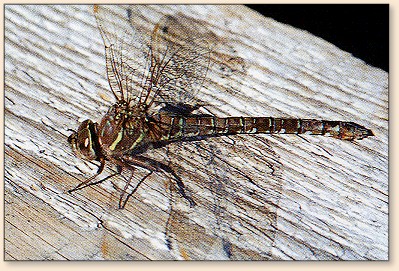Aeshnidae
The climbing nymphs from this family are
amongst the most aggressive predators found
in stillwaters. Adults are commonly referred
to as "darners." These fierce nymphs answer
only to each other, predaceous water beetle
larvae, giant water beetles and trout in the
productive lakes of western North America.
This family is widespread with over 38 known
species across the continent.
It is easy to distinguish these nymphs by their
long hourglass shaped bodies, large heads and
compound eyes. The long stocky legs provide lethal
stability in their never-ending quest for food.
Boldly stalking amongst the weed growth, rocks
and bottom debris, darner nymphs grow to an
appreciable size during their 3-to 4-year life
cycle. Specimens three inches long are common.
The first time I saw one of these large patrolling
nymphs in the shallows, I mistook it for a crayfish.
Their active lifestyle and large size make for an
active metabolism eclipsed only by my two sons.
Neatly camouflaged in shades of green, brown and
olive, it is amazing how close these cunning
predators can creep within their intended victim.
A swift extension of their under-slung jaw or a
short spurt and their hapless prey have no idea
what hit them. Only after molting does the nymph's
character change. Immediately after a recent instar
the nymph is a brilliant lime green dusted with
subtle purple flecks. Their huge, black eyes and
neon body makes them an obvious standout. Sensing
this vulnerability the nymph becomes shy and reclusive
until its new skin has hardened and returned to the
color of the surrounding environment.

In early summer the mature nymphs migrate along the
bottom and crawl out of the water to emerge. Owing
to their increased vulnerability the majority of
species within this family tend to hatch under the
cover of darkness. Those adults surviving the rigors
of emergence carry on where they left off as nymphs,
scouring the skies in search of mosquitoes,
Chironomids and other food sources. The adults
from this family are gigantic, many the size of
small birds, wingspans of 5 inches or more coupled
with a 4-inch body are not unheard of. The brilliant
blue-green adults live from 4 to 6 weeks. Late August
and early September sees the culmination of mating.
Then adults continue their bold flights until the
first frosts of the season put a close on their lives.
Libellulidae
The spider-like nymphs from this family are not
nearly as bold as their climbing cousins. With
over 90 species across North America, this family
is the most widespread amongst the dragonfly clan.
The sprawling nymphs from this family live in lakes,
ponds, ditches and sloughs. In the clear water lakes
of British Columbia and the western United States,
populations of these nymphs are dense. Favorite
haunts include chara weeds and semi-submerged
within the marl substrate. A coating of fine hairs
adorns the body of this squat nymph. These act as
a magnet for debris helping to camouflage this
efficient feeder. Common body colors include,
green, olive and shades of brown. The external
disguise this nymph carts around often obscures
its true colors. At maturity the nymphs seldom
exceed 1 1/2 inches. Not bold stalkers, nymphs
from this family prefer to lie in ambush, waiting
for their dinner to come to them. Hence their
nickname "sprawlers." When an unsuspecting scud,
mayfly nymph or other menu item bumbles into range,
the nymph waits patiently. Withholding its attack
until the last moment, the spoon-shaped labium
explodes outwards engulfing their prey. Up close,
the facial appearance of these sprawlers resembles
that of a medieval knight. The shy nature of this
nymph tends to mask its presence in many lakes.
Staying out of the limelight most of the time,
the only opportunity trout have to dine on these
nymphs is during their hatch migrations. Nonetheless
trout always respond well to a pattern crawled along
the bottom. Although complete with the jet-propulsion
system of all dragonfly families, sprawler nymphs
prefer to take their time going about their business.
Only when alarmed does this nymph take flight with
its front pair of legs held out front as stabilizers
while the rear pair trail back along the body.
After 2 to 3 years the nymph crawls ashore to
transform into the adult. The brilliantly colored
adults are visible from a distance. Libellulidae
adults differ from their Aeshnidae cousins not
only in color but size too. Adults seldom exceed
3 inches. The distinct black wing patches are
another trait of this family. Long-distance
flights are not as common with this family as
most adults mate and live out their lives,
never straying from their home waters. ~ PR
More on dragonflies for lakes from Phil Rowley's excellent book,
Fly Patterns for Stillwaters next time.
Credits: Excerpt from Fly Patterns
for Stillwaters By Philip Rowley, published
by Frank Amato Publications. We appreciate use
permission.
|


